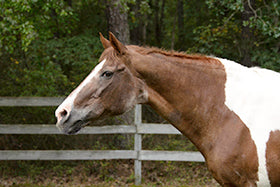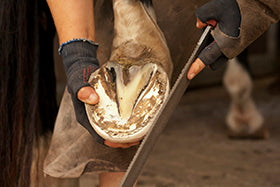How is steaming different from soaking hay?

soaking hay. Once we have diagnosed a horse with a respiratory condition, our initial conversation turns to environmental management of the horse. The most important things to consider when managing any horse with an airway issue include: the ventilation in the barn, bedding, and hay. When discussing the topic of hay, we always provide steaming and soaking as options for the horse and discuss the differences. Below is a simple chart showing the differences between steaming and soaking hay.
| Steaming Hay | Soaking Hay |
| - Reduces respirable particles by 99% |
- Reduces respirable particles by 90%* |
|
- Reduces bacteria & mold by 95% |
- Increases bacterial content of hay |
|
- Increases palatability |
- Can decrease palatability |
| - Preserves mineral and protein content |
- Decreases protein and mineral content |
|
- Decreases WSC (water soluble carbohydrates) |
- Decreases WSC’s |
*figure based on 10 minute soak time
It seems clear that the reduction of respirable particles is superior when steaming at high temperatures. Soaking hay can also closely achieve these numbers, however, if the hay is not consumed within a short amount of time, the hay is prone to mold. If the soaked hay dries, the respirable particles and mold spores can again affect the airways. This makes the consumption of soaked hay very time sensitive as well as labor intensive.
In addition, a dramatic increase in bacteria is seen after soaking, as much as 150% during a 10 minute soak. When high temperature steam is used, you get the opposite a dramatic decrease in bacteria and mold thereby improving the hygienic quality of the forage. Furthermore, the decrease in palatability means hay gets wasted and often bedding too if the horse mixes it into the bed. It can also be an issue for horses that not only need respiratory management, but weight gain as well. Those horses will likely not consume as much forage as they should.
Furthermore, the decrease in palatability means hay gets wasted and often bedding too if the horse mixes it into the bed. It can also be an issue for horses that not only need respiratory management, but weight gain as well. Those horses will likely not consume as much forage as they should.
The decrease in WSC’s is an important point to discuss. While steaming retains most of the nutritional value, both steaming and soaking can decrease water soluble carbohydrates (WSC) or sugar. However, WSC content is extremely variable between hays and the amount leached from both soaking and steaming is also variable. Therefore, owners wishing to limit the intake of sugar from hay should really test their hay.
The best option is to find a high-fibre hay, steam it and send a sample to a laboratory for WSC analyses. You can then see if the clean, steamed hay has a suitable nutritional value for a laminitis-prone horse. If a standard steam cycle is not enough, scientific research by Moore-Colyer et al 2014 recommends soaking first followed by a standard steam cycle in a Haygain so a combination of soaking and steaming can be used for this purpose.
Simply, steaming hay is the most effective and reliable way to condition hay. Soaking is an option but has some pitfalls that need to be considered when developing a management program.
Find out more
References:
Moore-Colyer, Meriel JS, “The Effect of Steaming and Soaking on the Respirable Particle, Bacteria, Mould, and Nutrient Content in Hay for Horses.” Journal of Equine Veterinary Science 39. 2016: 62-68
Brown, E., Tracey, S and Gowers, I. (2013) An investigation to determine the palatability of steamed hay, dry hay and haylage. Proceedings of British Society of Animal Science Conference, Nottingham April 2013. p 104.
Moore-Colyer MJS, Lumbis K, Longland AC, Harris PA. (2014).The effect of five different wetting treatments on the water soluble carbohydrate content and microbial concentration in hay for horses. Plos One.











